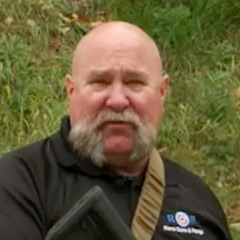
High Compressed Ready with a Rifle
J. HawkinsWhen considering shooting positions, you may be familiar with the high compressed ready position for handguns. J. Hawkins of Reno Guns & Range discusses the high compressed ready position for rifles and carbines. Having more points of contact with the body than a handgun gives the rifle an advantage. We want to make sure to use that advantage to our benefit.
Shooting Positions
Establish your grip around the pistol grip of the rifle with the trigger finger somewhere other than the trigger. The support hand should be forward on the foregrip to allow you to support the front weight of the rifle.
The toe, or the bottom back portion of the stock, should be in the chest, not in the shoulder, so that when facing forward on the target and in the proper stance, all you need to do is bring the rifle up, creating that kinesthetic alignment, and creating the cheek weld, which is the fourth point of contact.
Manipulating the Selector
At the same time that you’re raising the rifle to the fourth point of contact, you are also manipulating the selector from the safe position to the fire position. J. Hawkins always recommends that unless you have those four points of contact, the firearm should be on safe.
When you identify that there is a threat you need to address, bring the rifle on target, manipulate the selector from safe to fire, and address the threat appropriately. Once you’ve done that, you can return the rifle to the high compressed ready. Of all the shooting positions, it’s the one that allows you to have a greater field of view and lets you do so comfortably and for a long period of time.
You’ll find dozens of other rifle training videos here on the Personal Defense Network, to support your rifle training and practice.
You may be familiar with the high compressed ready with the handgun. Today, we're gonna discuss the high compressed ready with the rifle or carbine. The rifle, having more points of contact, does give give it an advantage. We also want to make sure that we have and use that advantage to our benefit. So when we look at the carbon, we're going to make sure that our grip is established around the pistol grip of the rifle with our trigger finger somewhere other than the trigger.
That our support hand is forward on the fore grip to allow us to support the front weight of the rifle. We want the toe, the bottom back portion of the stock to be into our chest, not the shoulder, but inside the chest so that when I'm facing forward on my target and am in my proper stance, all I have to do is rise with the rifle, creating that kinesthetic alignment, creating the cheek weld that I want here on my target. So as the same time as I'm raising the rifle to my fourth point of contact, I'm also manipulating the selector from the safe position to the fire position. One of the recommendations we make is that unless you are in that four points of contact we want the firearm to be in the safe position. When I identify that there's a threat that I need to address, I'm going to bring it on target manipulate the selector from safe to fire and address the threat appropriately.
Once I've done that, I can return to that high compress ready the position that allows me to have a greater field of view and I can do so comfortably for a great period of time. So this is just an example of our high compress ready with the carbine or rifle.

So is your non-trigger hand supposed to be pushed as far forward as possible as initially explained, or moved back to a position that requires expending less muscle strength and offers bones support as demonstrated?